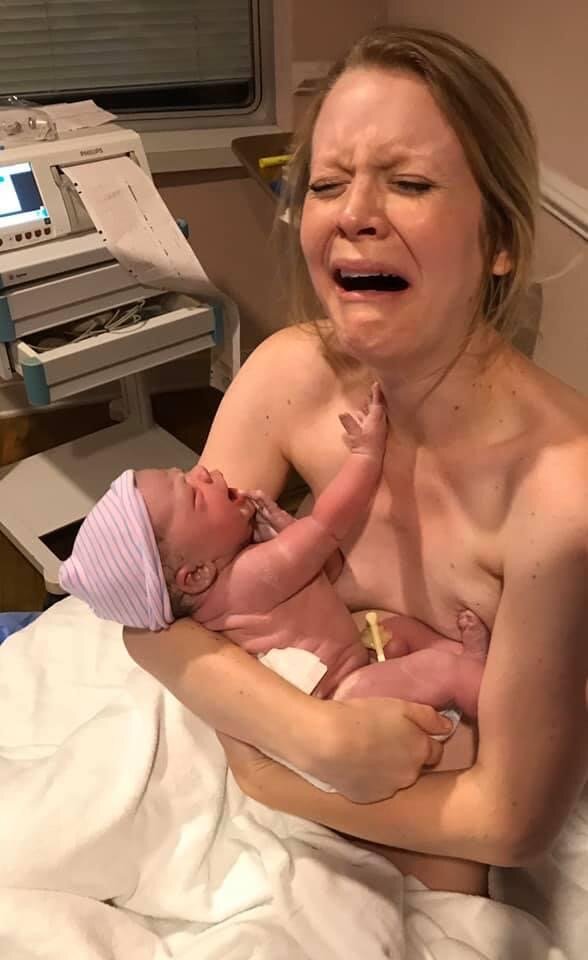I’ve been doing some soul searching the past few months in regard to birth, and the transition into a new year has brought the feelings and intention for change welling up inside me so much that I need to express them. So here I go. Those who are involved in the birth community of Hampton Roads as birthing families or birth workers, are aware that right before the pandemic hit our country full force, a beloved labor and delivery unit which included a midwife staffed birth center, closed its doors. This was a huge loss for our birthing community, one that was felt acutely by countless people locally but also spanned the globe as previous birthing families had moved away. After all, it had been in operation for over 25 years, and with our highly mobile military presence, their influence on birth and the beginning of parenting has spread far and wide. The Midwifery Center had tubs for laboring and birthing, which were a huge draw for many families. But more importantly, those who were intended to birth in the Center were met with openness. Their midwives listened and gave options, and trusted in the birthing woman and the innate safety of birth. And since there is always the potential for risk, the collaboration between midwives, OBs, and pediatricians, and nurses created the best of both worlds. As risk factors developed the elevated level of medical support was available. However, by and large, birth was safe and low risk, creating the opportunity for women to welcome their babies with minimal intervention. Options like intermittent monitoring, eating in labor to their comfort, laboring and birthing in a variety of positions, and even the option of laboring and giving birth in a tub were the norm.
The pandemic hit like a tidal wave right as so many were adjusting to ache of such a loss. The OB practice reestablished itself in a different facility, and with change come growing pains. To be frank, there was some resistance from staff in part due to lack of information or understanding, but also because the expectations of birthing women were significantly different than the status quo of birthing the staff had grown familiar with. Women who had come to expect a certain sort of care from their providers, were having to conform their wishes to the hospital rules and protocols, all while navigating the fear and panic brought on by COVID-19. To be fair, the pandemic affected the labor and delivery units of all of our hospitals. They struggled to balance safety and choice, all while incurring the additional responsibilities like COVID tests, enforcing mask wearing, and a higher level of PPE for the safety of all. However, many thought some of the COVID protocols were extreme with the risks and benefits balance questionable. Doulas were excluded from the birth space physically, relegated to virtual support at all hospitals, except one. Only one support person was allowed, leaving laboring women to make difficult choices about who would attend them. Babies were separated from moms with positive COVID tests, and masks were required by laboring women until a negative COVID result was confirmed. Women who tested positive would be required to mask up for the duration of their births. Many families chose to give birth at home where they still had a sense of agency in who would be present and how they would birth. This was a very good thing for our homebirth midwives as well as the families served, for it gave them a higher level of recognition and appreciation, while shining the light on birth as a natural process. Our homebirth midwives had more work than they could handle. And many in the birth community were very excited about it.
Yet here we are nearly 10 months later, still adjusting to this new normal. Some restrictions have been lifted, like virtual doulas and separation of moms and babies, with others in place to maintain a reasonable level of protection from transmission of the virus. But it is possible to normalize, embrace and accept low intervention birth even in the midst of the pandemic. It does not require a huge overhaul in policy, except perhaps the addition of birthing tubs. The change would involve a change in thinking. The time has come. ESPECIALLY in light of the pandemic. Birth is the same as it always was. The way we approach it has changed. At a time when fear for our health and safety has overhauled so many of our daily routines, we need to remember that birth for most continues to be normal and safe.
Collaborative care, evidence-based practices, and listening to birthing families, really hearing them out and having a dialogue with them, are what it will take to change the mindset of staff. And above all, trusting the birth process is absolutely essential. Childbirth education, in-depth thorough education about the process of birth brings a confidence to women—confidence in their bodies and their ability to tune in to it. And they also feel more comfortable laboring longer at home. But education and trusting the process must also happen from the hospital side. Childbirth education that goes beyond a standard medicalized birth is just as important for the hospital providers and staff serving laboring women. Yes, the interventions are there if needed or requested, but they should also learn how to serve a woman who does not desire those things. The care is quite different. Education is crucial to change mindset. For example, when a woman arrives at the hospital in labor, why not trust that they are actually in labor and skip the triage room? Triage brings with it the assumption that a woman might not be in labor, as if she must prove she is in labor before soiling a room. Why not assume she’s right and commit by admitting her to a room? If she has prepared for her birth with an in-depth childbirth education class series, she is much more likely to present in active labor. Education is a win-win scenario.
Things like dimming the lights, while seeming superficial, can do a lot to allow a woman to follow to her instincts and limit distractions. Music can also have a wonderful effect on the birthing environment and the temperament of the laboring woman and her support team. Aromatherapy is another way to do this, creating strong emotional responses that can relax and empower the birthing woman during key points in labor. As she nears delivery, that is not the time for lights to be switched on, a crowd to gather, and lots of rushing about. Late second stage is precisely when a minimal number of necessary support people enter quietly (without loud side conversations!) and take their places. This will better enable the woman to continue to birth in the way she had been up to that point, with limited distractions and the support of her core team. Only a nursery nurse is necessary unless elevated risk requires the presence of a pediatrician. All others are extraneous and very distracting.
After baby is born, and the baby is transitioning well—this does not have to involve aggressive rubbing of the baby for many minutes—the initial birth cry and subsequent movements and color changes are indicators that baby is transitioning. Evidence shows that babies transition best against mom’s skin. Mom can rub the bottoms of the feet to keep baby crying and alert just as well as a stranger can. The trained medical staff can glean a lot by looking and listening to baby. Intervene if necessary, but in most cases it’s not. Covering baby with a towel against mom skin-to-skin is the best way to maintain baby’s body heat. Rubbing the wetness off (and the valuable vernix!) doesn’t amount to much. Keep that towel still on baby she they can remain warm against mother’s skin and also benefit from the microbiome being established in part by that vernix.
And when it comes to breastfeeding, the first hour, deemed the magic hour in birthing vernacular, is for mom and baby to explore each other. It is not the time to rob a mother of her power by grabbing her breast and the baby’s head and show her how to feed her baby. There is plenty of time for that. Remember, one sustained feed in the first 24 hours is a normal expectation, even after presenting the breast every 2-3 hours during the day, and 3-4 hours overnight. Keep the lights dim to encourage baby to open eyes and take in mom, and try to limit lots of extraneous noise and side conversation. This hour is magical, remember. And it is made more magical by empowering mom and baby to learn and discover hunger cues and smells. The help is there if they need or ask for it. But don’t jump to intervene at the slightest delay of a latch.
I would love for women to have the option of laboring and birthing in tubs again. The evidence shows that it is safe and an excellent comfort measure for women in the most active part of labor. It’s a shame that it feels a bit elusive right now, but I know it can happen again with proper planning and exploring resources. Birthing families want options and that is an option in high demand but very limited availability.
I have seen midwives and OBs work side-by-side to insure the best outcomes for mom and baby. But I have also seen these same providers trust birth and trust a mother’s instincts when conditions are right and all is well, to birth how she wishes. I have been welcomed and respected as a member of the birth team, working alongside the medical staff and my clients as a valuable part. I have watched women feel strong, empowered, and trusted to know the best decisions to make for themselves and their babies. And I have seen women move forward into motherhood with the best possible start because of such agency in their birth and the respectful support received. Let’s come together to create normalcy in birth for options, less intervention, and trusting moms, and most of all for trusting birth. It can revolutionize not only the way birth looks, but the way birth feels, and the way mothering begins.








